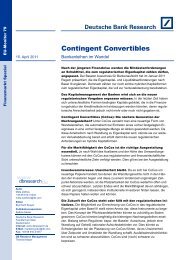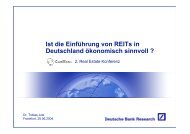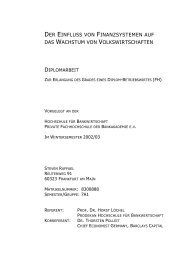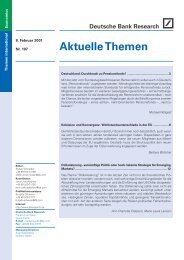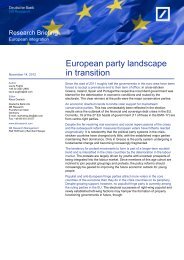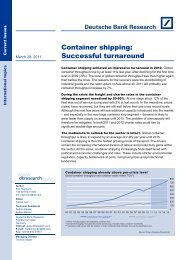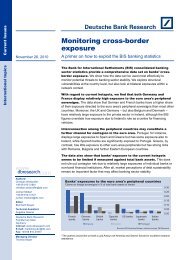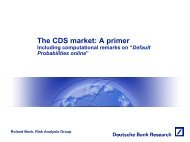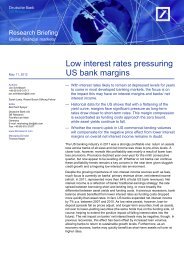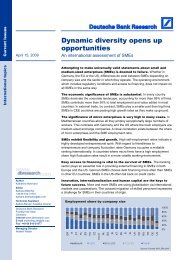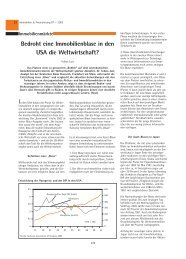Residential construction in Germany - Deutsche Bank Research
Residential construction in Germany - Deutsche Bank Research
Residential construction in Germany - Deutsche Bank Research
You also want an ePaper? Increase the reach of your titles
YUMPU automatically turns print PDFs into web optimized ePapers that Google loves.
10% of GDP<br />
Construction <strong>in</strong>vestment as % of GDP<br />
(nom<strong>in</strong>al)<br />
1970 1980 1990 2000<br />
18<br />
16<br />
14<br />
12<br />
10<br />
8<br />
6<br />
4<br />
2<br />
0<br />
2010<br />
<strong>Residential</strong> <strong>construction</strong><br />
Non-residential <strong>construction</strong><br />
Source: Destatis 1<br />
Correlation between<br />
<strong>construction</strong> and GDP<br />
Nom<strong>in</strong>al growth, % yoy<br />
1970 1980 1990 2000<br />
35<br />
30<br />
25<br />
20<br />
15<br />
10<br />
5<br />
0<br />
-5<br />
-10<br />
-15<br />
2010<br />
GDP<br />
<strong>Residential</strong> <strong>construction</strong><br />
Non-residential <strong>construction</strong><br />
Source: Destatis 2<br />
Moderate pick-up <strong>in</strong> build<strong>in</strong>g<br />
permits<br />
Number of approved hous<strong>in</strong>g units ('000)<br />
450<br />
400<br />
350<br />
300<br />
250<br />
200<br />
150<br />
100<br />
50<br />
0<br />
1992 1995 1998 2001 2004 2007 2010<br />
S<strong>in</strong>gle and two-family dwell<strong>in</strong>gs<br />
Multi-family dwell<strong>in</strong>gs<br />
Source: Destatis 3<br />
Introduction<br />
Current Issues<br />
In 2010, nom<strong>in</strong>al <strong>in</strong>vestment <strong>in</strong> <strong>construction</strong> totalled nearly<br />
EUR 250 bn <strong>in</strong> <strong>Germany</strong>. <strong>Residential</strong> <strong>construction</strong> alone accounted<br />
for over EUR 140 bn of this total, with the rest divided between nonresidential<br />
commercial <strong>construction</strong> and civil eng<strong>in</strong>eer<strong>in</strong>g projects.<br />
Construction <strong>in</strong>vestment thus generates around 10% of <strong>Germany</strong>‘s<br />
gross domestic product (GDP); this roughly equals the mean for<br />
Western Europe. Significantly higher read<strong>in</strong>gs are often a reflection<br />
of catch<strong>in</strong>g-up processes, as is currently the case <strong>in</strong> Eastern<br />
Europe, or of overheat<strong>in</strong>g, as <strong>in</strong> Spa<strong>in</strong> and Ireland before 2007.<br />
The absolute volume of residential <strong>construction</strong> alone does not<br />
determ<strong>in</strong>e its overall economic significance, though. The political<br />
and social value attached to hous<strong>in</strong>g as a good as well as the<br />
pronounced volatility of the sector also play a part: <strong>in</strong> recession<br />
years residential <strong>construction</strong> experiences a particularly strong<br />
slump, whereas <strong>in</strong> boom phases the sector outstrips the economy<br />
as a whole. This is why the standard deviation for the growth rate of<br />
residential <strong>construction</strong> has been over twice as high as for GDP over<br />
the past 40 years. These characteristics also make residential<br />
<strong>construction</strong> a popular target for economic and (re-)distribution<br />
policies. In <strong>Germany</strong>, very expansionary residential-<strong>construction</strong><br />
policy measures triggered sizeable growth stimuli <strong>in</strong> the early 1990s,<br />
but as special depreciation charges, accelerated depreciation<br />
schedules and the home-ownership grant were gradually abolished<br />
or at least curtailed over the subsequent years, the result was a<br />
last<strong>in</strong>g recession <strong>in</strong> residential build<strong>in</strong>g and weak house prices. The<br />
development of residential build<strong>in</strong>g permits and completions gives a<br />
very good illustration of this adjustment burden: <strong>in</strong> the multi-family<br />
segment the number of hous<strong>in</strong>g units approved fell by over 80%<br />
with<strong>in</strong> ten years, while for s<strong>in</strong>gle and two-family dwell<strong>in</strong>gs the<br />
decl<strong>in</strong>e came to 60%.<br />
Over the past few years many hous<strong>in</strong>g markets have stabilised. A<br />
resumption of <strong>in</strong>come growth and still comparatively low mortgage<br />
rates are currently driv<strong>in</strong>g up the price of rental accommodation and<br />
house prices. 1 In 2010, rents and prices <strong>in</strong>creased by 2-3% <strong>in</strong><br />
<strong>Germany</strong>‘s major cities. While this represents an only modest climb<br />
by <strong>in</strong>ternational standards, for <strong>Germany</strong> it translates <strong>in</strong>to the biggest<br />
jump s<strong>in</strong>ce 1994.<br />
This development raises several key questions: how close is the<br />
correlation between house prices and build<strong>in</strong>g activity? Does a<br />
recovery <strong>in</strong> the hous<strong>in</strong>g markets also trigger a significant resumption<br />
of build<strong>in</strong>g activity? Which regions are likely to see the most<br />
pronounced recovery?<br />
There are tentative signs of reviv<strong>in</strong>g activity <strong>in</strong> the residential<br />
<strong>construction</strong> sector – build<strong>in</strong>g permits are up by around 10% s<strong>in</strong>ce<br />
the 2008 low. And, <strong>in</strong> the first 5 months of 2011 the number of<br />
residential build<strong>in</strong>g permits actually jumped by over 30% yoy. Does<br />
this provide clear evidence of a trend reversal?<br />
1 See Just, T. (2010).<br />
2 August 22, 2011



